Research
Cryo-EM
Ordering at the BNNT Water Interface
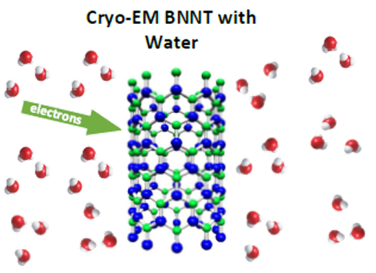
This project will address the topics of ordering and transport of BNNT with water. Due to BNNT’s similar interatomic distance with respect to low density amorphous (LDA) water [1], [2], we predict that there exists preferential ordering at the interface between water and BNNT. Previous transport measurements of water in BNNT supports this expectation [3].
[1] M. Ishigami, S. Aloni, and A. Zettl, Am. Inst. Phys. (2003) p. 94–99.
[2] S. J. Perkins, Eur. J. Biochem. 157 (1986), p. 169–180.
[3] E. Secchi, et al. Nature 537 (2016), p. 210–213.
Nanoconfined Fluids in Single-Digit Nanopores
This project aims at imaging nanoconfined fluids in single-digit nanopores (SDNs) with cryo-EM. We have developed methods for the high resolution imaging of fluidic structure and individual ions in confined SDNs by rapidly cooling the native structure in a vitreous state and imaging by high resolution electron microscopy. Implementing postive charge ions such as Na+ and Lu3+ and negatively charged functionalized nanoparticles, we anticipate charge inversion to occur resulting in inversion of the Zeta potential and formation of an electrical double layer. Direct observation of the double layer and diffusion layer is possible [1] but is primarily limited by the size of the ion. We use off-axis Electron Holography [2] to understand the electrica nature of ions in solutions at interfaces and under nanoscale confinement.
[1] Li, H.-K. et al. Nano Lett. 20, 7927–7932 (2020). 10.1021/acs.nanolett.0c02669
[2] Lehmann, M. & Lichte, H. Microsc. Microanal. 8, S1431927602029938 (2002). 10.1017/S1431927602029938
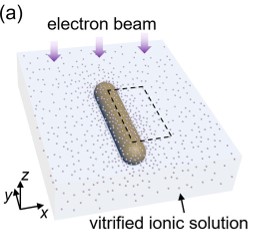
In-situ TEM holders
Electron Beam Induced Current (EBIC) in GaN
Space exploration, and the understanding of our universe, requires sophisticated and delicate navigational equipment and research instrumentation. The harsh radiation environment can damage the on-board electronics rendering the space mission objectives obsolete. For example, engineers used a 500 lb titanium radiation vault to protect the electronics on the spacecraft Juno that is currently in orbit around Jupiter. I am interested in studying semiconductor materials such as gallium nitride (GaN) which exhibits higher radiation-resistant properties than the currently common silicon devices, as one strategy to try to replace the heavy, fuel inefficient vaults.
We study the effect of electron beam irradiation on the minority carrier diffusion length of n-type GaN, in both bulk (100 μm) and thinned (100 nm) GaN. We have previously demonstrated a sample preparation and experimental setup which allows us to reproducibly collect STEM electron beam induced current (EBIC) images of bulk GaN, which was published in a recent conference paper in the journal of Microscopy and Microanalysis.[1] The expected contribution of this work is to provide experimental data of high energy electron beam irradiation of bulk and thin GaN. Using this technique, we can both quantitatively measure important GaN device properties as well as study the effect of electron beam damage.
[1] Z. Warecki et al., Microsc. Microanal., vol. 24, no. S1, pp. 1842–1843, 2018. 10.1017/S1431927618009698
Cobalt Catalyst with SWCNT Growth
In this project, we hope to understand the adhesion, growth, and deactivation of the SWCNT with Co catalyst. We hypothesize the ability for nanotube growth depends on both the catalyst phase and the faceted planes of the catalyst surface. In addition, we propose that the work of adhesion between the nanotube and catalyst interface will play a critical role in the determination of growth.
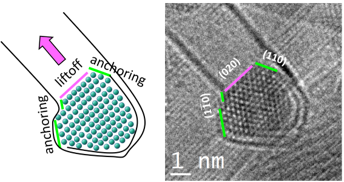
Boron nitride nanotube electron-beam induced oxidation at 80kV
This project explores the degradation mechanism of the BNNT versus CNT. We postulate that the BNNT would be able to withstand a higher amount of radiation in an oxygenated environment before oxidation compared to CNT. Though experimentation, we also desire to pinpoint a mechanistic model for radiation-induced oxidation.
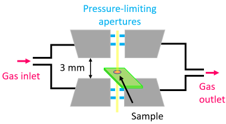
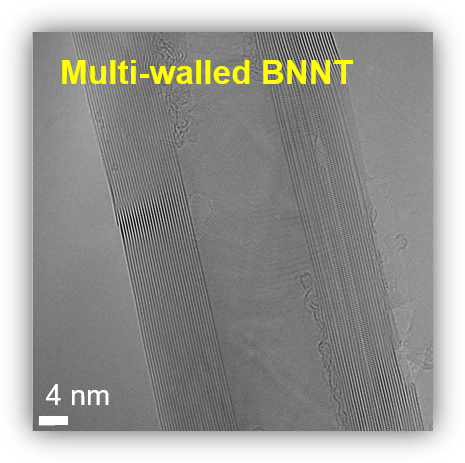
Nanomagnetism
In a world where data storage is essential, we must pioneer new ways to break through the superparamagnetic limit. The motivation for our magnetic research is to manipulate the features of materials and change their characteristics to fit the needs of society. For example, providing precise control over local magnetism that can be applied to MRAM (magnetic random access memory) by switching discrete magnetic states. These studies focus on how nanoscale features influence electric and magnetic properties of the materials. The Cumings Group studies lattice structures, and the influence of particle shape and size on these properties. These features can be examined in the TEM using Lorentz microscopy. These images [1] show a topological defect in an artificial spin ice, which shows a 180 degree phase shift in the antiferromagnetic order parameter of the ground state.
[1] J. Drisko, T. Marsh, and J. Cumings, Nat. Commun, 8, 14009 (2017). 10.1038/ncomms14009
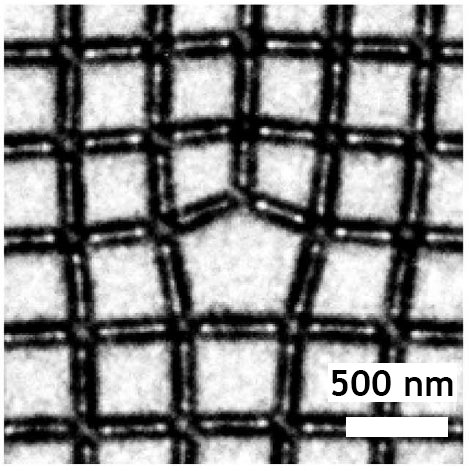
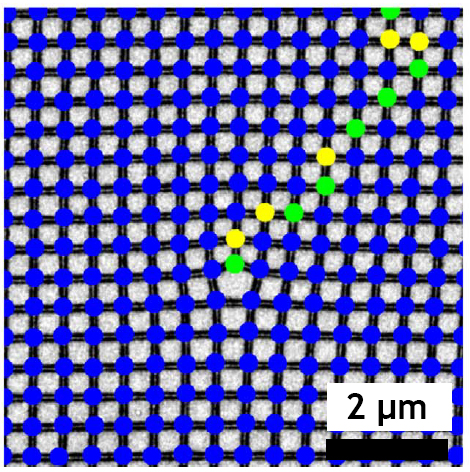
Liquid Cell
Nanoscale Confinement
Fresh, clean non-salt water is required for a vast array of industrial applications and as drinking water. Desalination, the process of removing salt from water, is often achieved by reverse osmosis (RO) but is expensive. A major cost to RO plants is lime scaling in feed lines and filters. As salt water passes through feed lines to the filter, the salt deposites onto the wall eventually blocking the pipe entirely. Cleaning methods are ineffectual thus requireing replacement of the pipe or filter. Therefore, understanding of the precipitation pathways and precursors is of vital importance.
This project aims to image confinement-induced precipitation in nanopores. Probing the arrangement of liquid-surface interfaces in the presence of multivalent and precipitation ions, both during in-situ potential driving and cryo-EM, is a continuation of 1. Understanding precipitate formation structure related to geometry is of substantial importance in commercial industries such as desalination.
[1] Powell, M. R. et al. Nat. Nanotechnol. 3, 51–57 (2008). 10.1038/nnano.2007.420
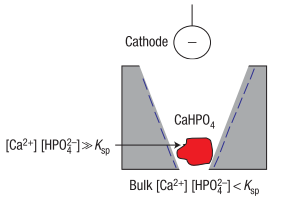
In-situ STEM liquid cell electrochemical studies of lithium-alloying anodes
Battery materials play a critical role in the development of energy storage technology to enable fossil fuel alternatives in intermittent renewable energy, such as solar and wind energy. The scanning transmission electron microscope (STEM) provides the perfect opportunity to observe and understand the working of lithium ion battery electrodes at the sub-micron scale. With a specialized set-up, I can convert the microscope into a “mini-lab,” where I can cycle a battery all the while observing the processes in real time. We are leveraging the Electrochemical-Cell (EC) Discovery Platform, [1] designed at the Center for Integrated Nanotechnologies (CINT) at the Sandia National Laboratory. The EC Discovery Platform is an enclosed liquid cell capable of withstanding the extremely high vacuum inside the TEM. I have designed and developed a new specialized TEM holder, which is compatible with UMD JEOL microscopes. We plan to use the JEOL 2100F STEM capabilities to observe the effect of cycling in an enclosed liquid electrolyte environment on lithium-alloying anode materials, such as tin and silicon anodes.
[1] A. J. Leenheer, et al., J. Microelectromechnical Syst., vol. 24, no. 4, pp. 1061–1068, 2015. 10.1109/JMEMS.2014.2380771
